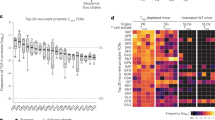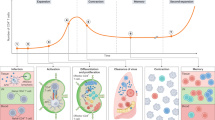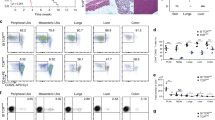Abstract
Although bone marrow is known as a primary lymphoid organ, its potential to serve as a secondary immune organ has hardly been explored. Here we demonstrate that naive, antigen-specific T cells home to bone marrow, where they can be primed. Antigen presentation to T cells in bone marrow is mediated via resident CD11c+ dendritic cells. They are highly efficient in taking up exogenous blood-borne antigen and processing it via major histocompatibility complex class I and class II pathways. T-cell activation correlates with dendritic cell–T cell clustering in bone marrow stroma. Primary CD4+ and CD8+ T-cell responses generated in bone marrow occur in the absence of secondary lymphoid organs. The responses are not tolerogenic and result in generation of cytotoxic T cells, protective anti-tumor immunity and immunological memory. These findings highlight the uniqueness of bone marrow as an organ important for hemato- and lymphopoiesis and for systemic T cell–mediated immunity.
This is a preview of subscription content, access via your institution
Access options
Subscribe to this journal
Receive 12 print issues and online access
$209.00 per year
only $17.42 per issue
Buy this article
- Purchase on Springer Link
- Instant access to full article PDF
Prices may be subject to local taxes which are calculated during checkout






Similar content being viewed by others
References
Fu, Y.-X. & Chaplin, D.D. Development and maturation of secondary lymphoid tissues. Annu. Rev. Immunol. 17, 399–458 (1999).
Lanzavecchia, A. & Sallusto, F. The instructive role of dendritic cells on T cell responses: lineages, plasticity and kinetics. Curr. Opin. Immunol. 13, 291–296 (2001).
Banchereau, J. et al. Immunobiology of dendritic cells. Annu. Rev. Immunol. 18, 767–811 (2000).
Osmond, D.G. Production and selection of B lymphocytes in bone marrow: lymphostromal interactions and apoptosis in normal, mutant and transgenic mice. Adv. Exp. Med. Biol. 355, 15–20 (1994).
Koni, P.A. et al. Conditional vascular cell adhesion molecule 1 deletion in mice: impaired lymphocyte migration to bone marrow. J. Exp. Med. 193, 741–753 (2001).
Khazaie, K. et al. Persistence of dormant tumor cells in the bone marrow of tumor cell vaccinated mice correlates with long-term immunological protection. Proc. Natl. Acad. Sci. USA 91, 7430–7434 (1994).
Masopust, D., Vezys, V., Marzo, A.L. & Lefrancois, L. Preferential localization of effector memory cells in non-lymphoid tissue. Science, 291, 2413–2416 (2001).
Marshall, D.R. et al. Measuring the diaspora for virus-specific CD8+ T cells. Proc. Natl. Acad. Sci. USA 98, 6313–6318 (2001).
Kuroda, M.J. et al. Simian immunodeficiency virus-specific cytotoxic T lymphocytes and cell-associated viral RNA levels in distinct lymphoid compartments of SIV mac-infected rhesus monkeys. Blood 96, 1474–1479 (2000).
Feuerer, M. et al. Enrichment of memory T cells and other profound immunological changes in the bone marrow from untreated breast cancer patients. Int. J. Cancer 92, 96–105 (2001).
Müller, M. et al. EblacZ tumor dormancy in bone marrow and lymph nodes: active control of proliferating tumor cells by CD8+ immune T cells. Cancer Res. 58, 5439–5446 (1998).
Feuerer, M. et al. Therapy of human tumors in NOD/SCID mice with patient-derived reactivated memory T cells from bone marrow. Nat. Med. 7, 452–458 (2001).
Kearney, E.R., Pape, K.A., Loh, D.Y. & Jenkins, M.K. Visualization of peptide-specific cell immunity and peripheral tolerance induction in vivo. Immunity 1, 327 (1994).
Limmer, A. et al. Efficient presentation of exogenous antigen by liver endothelial cells to CD8+ T cells results in antigen-specific T cell tolerance. Nat. Med. 6, 1348–1354 (2000).
Sanderson, S. & Shastri, N. LacZ inducible antigen/MHC-specific T cell hybrids. Int. Immunol. 6, 369–376 (1994).
Förg, P., von Hoegen, P. & Schirrmacher, V. Superiority of the ear pinna over muscle tissue as site for DNA vaccination. Gene Ther. 5, 789–797 (1998).
Miyawaki, S. et al. A new mutation, aly, that induces a generalized lack of lymph nodes accompanied by immunodeficiency in mice. Eur. J. Immunol. 24, 429–434 (1994).
Hommel, M. & Kyewski, B. Dynamic changes during the immune response in T cell-APC clusters isolated from lymph nodes. J. Exp. Med. 197, 269–280 (2003).
Aichele, P. et al. Peptide antigen treatment of naïve and virus-immune mice: antigen-specific tolerance versus immunopathology. Immunity, 6, 519–529 (1997).
Coles, R.M., Mueller, S.N., Heath, W.R., Carbone, F.R. & Brooks, A.G. Progression of armed CTL from draining lymph node to spleen shortly after localized infection with herpes simplex virus 1. J. Immunol. 168, 834–838 (2002).
Berlin-Rufenach, C. et al. Lymphocyte migration in lymphocyte function-associated antigen (LFA)-1-deficient mice. J. Exp. Med. 189, 1467–1478 (1999).
Tripp, R.A., Topham, D.J., Watson, S.R. & Doherty, P.C. Bone marrow can function as a lymphoid organ during a primary immune response under conditions of disrupted lymphocyte trafficking. J. Immunol. 158, 3716–3720 (1997).
Bain, B.J., Clark, D.M., Lampert, I.A. & Wilkins, B.S. Bone Marrow Pathology. edn. 3 114–116 (Blackwell Science, London, 2001).
Ruedl, C., Koebel, P., Bachmann, M., Hess, M. & Karjalainen, K. Anatomical origin of dendritic cells determines their life span in peripheral lymph nodes. J. Immunol. 165, 4910–4916 (2000).
Kamath, A.T. et al. The development, maturation, and turnover rate of mouse spleen dendritic cell populations. J. Immunol. 165, 6762–6770 (2000).
Norbury, C.C., Hewlett, L.J., Prescott, A.R., Sharstri, N. & Watts, C. Class I MHC presentation of exogenous soluble antigen via macropinocytosis in bone marrow macrophages. Immunity 43, 783–791 (1995).
Jung, S. et al. In vivo depletion of CD11c+ dendritic cells abrogates priming of CD8+ T cells by exogenous cell-associated antigens. Immunity 17, 211–220 (2002).
den Haan, J.M.M., Lehar, S.M. & Bevan, M.J. CD8+ but not CD8− dendritic cells cross-prime cytotoxic T cells in vivo. J. Exp. Med. 192, 1685–1695 (2000).
Kaech, S.M. & Ahmed, R. Memory CD8+ T cell differentiation: initial antigen encounter triggers a developmental program in naïve cells. Nat. Immunol. 2, 415–422 (2001).
Veiga-Fernandes, H., Walter, U., Bourgeois, C., McLean, A. & Rocha, B. Response of naïve and memory CD8+ T cells to antigen stimulation in vivo. Nat. Immunol. 1, 47–53 (2000).
Hogquist, K.A. et al. T cell receptor antagonist peptides induce positive selection. Cell 76, 17–27 (1994).
Karrer, U. et al. On the key role of secondary lymphoid organs in antiviral immune responses studied in alymphoplastic (aly/aly) and spleenless (Hox11−/−) mutant mice. J. Exp. Med. 185, 2157–2170 (1997).
Lakkis, F.G., Arakelov, A., Konieczny, B.T. & Inoue, Y. Immunologic ignorance of vascularized organ transplants in the absence of secondary lymphoid tissue. Nat. Med. 6, 686–688 (2000).
Chin, R., Zhou, P., Alegre, M.-L. & Fu, Y.X. Confounding factors complicate conclusions in aly model. Nat. Med. 7, 1165–1166 (2001).
Li, M. et al. Cell-associated ovalbumin is cross-presented much more efficiently than soluble ovalbumin in vivo. J. Immunol. 166, 6099–6103 (2001).
Krüger, A., Schirrmacher, V. & von Hoegen, P. Scattered micrometastasis visualized at the single cell level: detection and re-isolation of lacZ labeled metastasized lymphoma cells. Int. J. Cancer 58, 275–284 (1994)
Robertson, J.M., Jensen, P.E. & Evavold, B.D. D011.10 and OT-II T cells recognize a C-terminal ovalbumin 323-339 epitope. J. Immunol. 164, 4706–4712 (2000).
Kärre, K., Ljunggren, H.G., Piontek, G. & Kiessling, R. Selective rejection of H-2 deficient lymphoma variants suggests alternative immune defence strategy. Nature 319, 675–678 (1986).
Falo, L.D. Jr., Kovacsovics-Bankowski, M., Thompson, K. & Rock, K.L. Targeting antigen into the phagocytic pathway in vivo induces protective tumor immunity. Nat. Med. 1, 649–653 (1995).
Acknowledgements
We thank T. Schüler and K. Hogquist for OT-I/Rag1−/− mice; R. Zinkernagel for Map3k14aly/aly mice; G. Moldenhauer and P. Altevogt for antibodies; G. Kübelbeck and K. Tauber for RMA-OVA cells; P. Angel for a construct with a ubiquitin promoter; A. Griesbach for mouse splenectomy; K. Hexel for help with cell sorting; M. Gehring for technical assistance; and H. Müssig for secretarial assistance. We thank the NIAID Tetramer Facility and NIH AIDS Research and Reference Reagent Program for providing H-2Ld/peptide tetrameric complexes. We thank the M. Scheel-Stiftung (no. 10-1589-Schi5) for financial support.
Author information
Authors and Affiliations
Corresponding author
Ethics declarations
Competing interests
The authors declare no competing financial interests.
Supplementary information
Rights and permissions
About this article
Cite this article
Feuerer, M., Beckhove, P., Garbi, N. et al. Bone marrow as a priming site for T-cell responses to blood-borne antigen. Nat Med 9, 1151–1157 (2003). https://doi.org/10.1038/nm914
Received:
Accepted:
Published:
Issue Date:
DOI: https://doi.org/10.1038/nm914
This article is cited by
-
The contribution of sleep to the neuroendocrine regulation of rhythms in human leukocyte traffic
Seminars in Immunopathology (2022)
-
Increased activated regulatory T cell subsets and aging Treg-like cells in multiple myeloma and monoclonal gammopathy of undetermined significance: a case control study
Cancer Cell International (2018)
-
ADAMTS1 protease is required for a balanced immune cell repertoire and tumour inflammatory response
Scientific Reports (2018)
-
Mechanisms of T cell organotropism
Cellular and Molecular Life Sciences (2016)
-
Chemotherapie und/oder Immuntherapie?
Wiener klinisches Magazin (2016)



